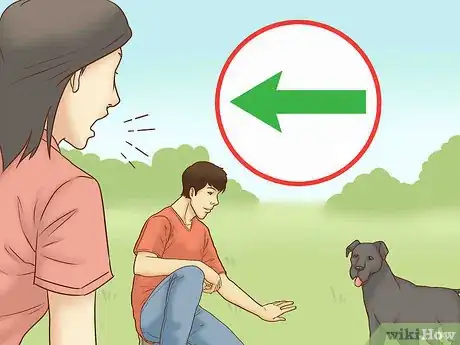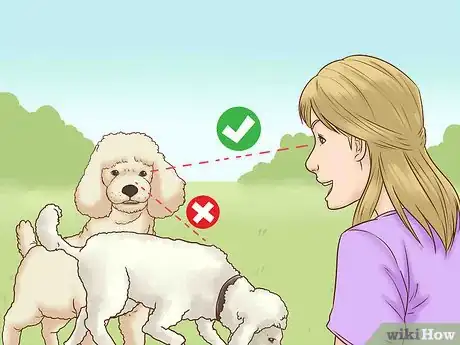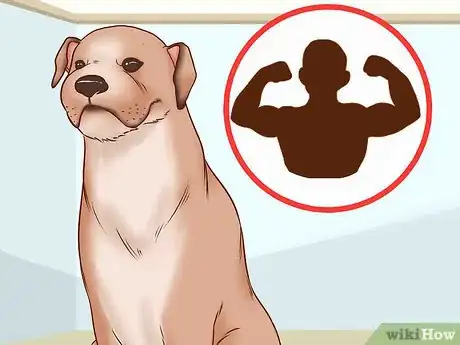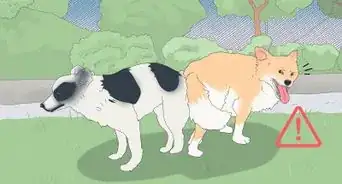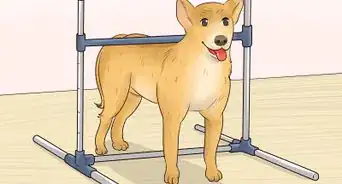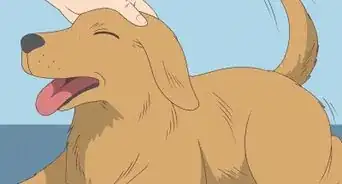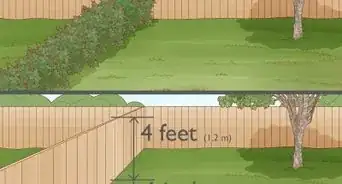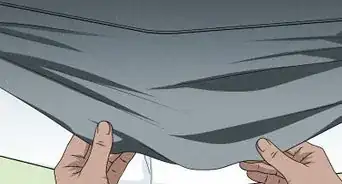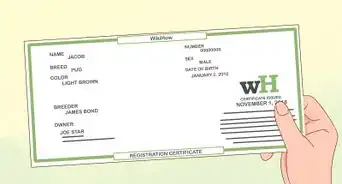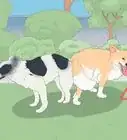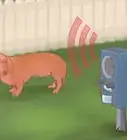This article was co-authored by Lauren Baker, DVM, PhD. Dr. Lauren Baker is a Veterinarian and Assistant Scientist at the University of Wisconsin-Madison. With over 10 years in veterinary medicine, she specializes in the concept of “one health,” which uses insights from veterinary medicine to help human medical research. She holds a Ph.D. in Comparative Biomedical Sciences, a Doctor of Veterinary Medicine, an MS in Comparative Biomedical Sciences, and a Bachelor’s degree in Psychology from the University of Wisconsin-Madison.
This article has been viewed 31,500 times.
It’s natural for dogs to be distracted by instinctual drives like chasing, fleeing or roaming, but having a dog that does not pay attention to you can be a serious liability. Besides being annoying, it can compromise their and others’ safety. However, if you train your pooch to have good recall and focus on you in spite of their environment, regaining their attention whenever they’re tempted by distractions should be a piece of cake. When you improve and consistently reinforce your dog’s training, you’ll never have to worry about working hard to get your dog’s attention.
Steps
Teaching Your Dog Good Recall
-
1Decide on a recall cue. The first step to getting your dog’s attention is to get them to come when you call. It’s basic and vital training for a dog’s safety and your sanity. The most common recall command is “come” paired with your dog’s name before or after.[1]
- Because it’s likely that your dog hears their name frequently in many different contexts, their name alone is usually not an effective recall cue.
- You could also consider using a sound, like a whistle, as a recall cue. This might be a good idea if you plan on recalling your dog from long distances since the sound will generally carry further than your voice.
- You might also want to add a hand signal, such as putting a hand, finger, or fist in the air, to the cue since there may some instances in which your dog will be able to see you better than they can hear you.[2]
-
2Give your dog positive associations with the cue. Once you’ve decided on the command, be sure that it’s freighted with positive associations. Repeat the word several times, giving your dog a high-value treat with each repetition. At this stage, you are not actually asking your dog to do anything in return for the treats; you’re simply building a strong connection between the cue and rewards.[3]
- Do this several times over the course of a week to build up your dog’s positive associations with the command.
- High-value treats are special. They shouldn’t be ordinary kibble or training treats. They should be bigger dog treats or foods that your dog really loves, like chicken, lunch meat, or cheese. The treat could also be a special toy that’s used only for training.
- Vary the treats to keep things exciting for your dog.
Advertisement -
3Practice “come” in a controlled environment. Now that your dog associates your recall cue with high rewards, they should be ready to pay attention to the command and go towards you to see what treat you have for them. Start by working with another person in a controlled setting, like a hallway or a fenced-in yard. Have the other person kneel facing you and holding your dog.[4]
- Once you give the recall cue, the other person should release your dog to let them go to you. Reward your dog with a high-value treat and affectionate praise as soon as they arrive.
- Start with a very short distance and gradually increase the distance over the course of each session. If they fail to come, go back down a step and try again.
- If you’re having difficulty getting your dog’s attention, try holding a toy they really love while you say the recall cue. Squeaky toys are especially good for this because the sound will make it easy to get your dog's focus.
- Repeat this exercise several times over the course of a couple weeks until it’s ingrained in your dog that the recall cue means “come.”
- Another way to reinforce the cue by yourself is to give the command every time that your dog is coming to you of their own accord. Say the cue while they’re on their way, and reward them with a treat and/or praise when they arrive.
-
4Practice the “come” command with distractions. Once your dog has mastered recall in a controlled environment with no distractions, it’s time to put them to the test in trickier circumstances. If they come to you in spite of outside temptations, you can be sure that you’ll be able to get their attention in the future.[5]
- For instance, start by practicing outside with your dog on a long lead. Once they have that down, get a friend to try and distract them with play or toys while you recall them. From there, you might graduate to recalling them when they’re in a crowded dog park.
-
5Repeat their recall exercises often. Dogs respond best to training that is offered in many short sessions over a long period of time. Devote a few minutes once or twice a day to recall training, and your dog will develop strong recall.[6]
- Make sure to go at your dog’s pace. Some dogs will pick up a “come” command within a week. More often, it will take a month or more for your pooch to get their recall down.
- As they get more proficient at recall, remember to keep increasing the challenge of the exercises by making the distances and/or distractions greater. If they slip up, go back to the previous stage before you try moving on again.
-
6Avoid negative training. In order to encourage a strong recall, you have to be sure that you’re not inadvertently reinforcing bad habits. The main things to avoid are punishing your dog for not paying attention or rewarding them for not paying attention immediately.[7]
- Never scold or discipline your dog if they don’t come to you right away. Doing so will make them less likely to want to return the next time.
- Avoid repeating the “come” command or recall cue more than once. You want to teach your dog to come immediately. If you reward them for coming after you’ve given the command ten times, you’re telling them that it’s okay not to pay attention the first nine times.
Training Your Dog to Focus on You
-
1Decide on a focus cue. The most common is “look” paired with your dog’s name. You can use any word that you like, but keep it short and snappy. You could also use a noise like clicking your tongue or smacking your lips as a cue. It doesn’t need to be loud since this command should be given only when you’re in close proximity to your dog.
- You may want to pair this cue with a hand signal, like pointing at your eyes, so that you can visually reinforce the cue and easily release your dog from the stare by putting your hand down.
-
2Reward your dog for making eye contact. Pick a treat or special toy reserved only for training that your dog really loves. Have your dog sit in front of you, show them the reward in your hand, and gradually move it up towards your eyes.[8]
- The minute your dog shifts their focus from the reward to your eyes, give them a reward and vocal praise (like, “good girl!”). If you’re using treats, give them a treat. If you’re using a toy, let them have the toy.
- If your dog is failing to make eye contact with you, try this exercise using two treats instead. Put one treat in each of your hands, and hold your hands up on either side of your eyes with the treats exposed. That way, your dog will have trouble focusing on just one, making it more likely for them to divert their gaze to your eyes as they shift their attention back and forth.
- Remember, at this point, you are using your action with the treat(s) rather than the focus command itself to gain your dog’s attention. This allows you to imbue eye contact with positive connections before you associate it with a specific vocal and/or visual cue.
- Practice this several times in short daily sessions before moving on to the next step.
-
3Add your focus cue to the exercise. Now that your dog knows that eye contact with you is a good thing, it’s time to associate it with a specific command. Repeat the same exercise as above, but give the focus cue just before you reach eye-level with your dog’s reward.[9]
- After you’ve used the cue in several short training sessions, try giving the command without using the treat to guide their gaze. Simply have them sit in front of you, give them the cue, and reward and praise them when they make eye contact.
-
4Make your dog hold focus for longer. Once your dog associates your cue with making eye contact with you, it’s time to increase the challenge by making them hold their stare for longer. Gradually increase the amount of time that they have to make eye contact with you over the course of each training session before they get their reward.
-
5Test them with distractions. The easiest way to do this is to go on a walk with your dog on a leash. Whenever there’s something that would usually draw their attention, such as a squirrel, fellow dog, or skateboarder, give them the focus cue and reward their attention.
Minimizing Your Dog’s Inattentiveness
-
1Be patient and consistent. Teaching your dog to focus on you and practice impulse control is a long process that can take months. Patient repetition is the best guarantee of success. Always use the same commands and offer positive responses to get the best results.
-
2Keep training interesting. While consistency is best when it comes to your commands and responses, your dog will get bored with the same routines. Vary the types of rewards and circumstances in which you practice to hold their attention and keep them learning.
-
3Give your dog sufficient exercise. Dogs are often hyper and misbehave when they have pent-up energy. It’s hard to keep your pooch’s attention when they’re bursting with energy, so be sure to give them daily walks and play sessions.[10]
- The necessary amount will vary according to your dog’s age, breed, and fitness. However, most dogs need a minimum of 30-60 minutes of aerobic exercise per day.
-
4Address your dog’s drives. Often times, the things that distract your dog are due to their instinctual drives to chase, play, and hunt. Training your dog to have strong focus and recall is the best way to control these drives. However, it also helps if you can channel these drives into controlled activities. That way, your dog can act on their impulses in a safe way while still focusing on you.[11]
- For instance, if your dog loves to chase, play fetch with them or teach them to catch a frisbee. If your dog loves to hunt or chew, play tug or get a toy that has a furry ball on the end of a long rope for them to pounce on (at a safe distance from you).
-
5Build your dog’s confidence. If your dog is frequently distracted by things that frighten them, sometimes the key to gaining their attention is to boost their confidence. Training and socialization are both great ways to make your dog more self-assured.[12]
- Training includes the recall and focus exercises described above. Attending a basic obedience class with your pooch can also go a long way towards boosting their confidence.
- Socialization involves introducing your dog to a variety of new environments over time. Comfort them if they have an anxious reaction to a new place, and reward them when they’re at ease with a new place.
- Socialization also involve introducing your dog to new people and animals. If your dog is wary of strangers, start by letting them watch others at a distance while you reward them and speak reassuringly to them.
Warnings
- Do not let your dog off their leash in an uncontrolled area until you are sure that you can consistently regain their attention.⧼thumbs_response⧽
- Do not chase after your dog when they run after a distraction. Doing so can make them run further since they think you’re participating in the game. Instead, try to encourage your dog to chase after you.⧼thumbs_response⧽
References
- ↑ http://www.whole-dog-journal.com/issues/11_12/features/Teaching-a-Reliable-Recall_16085-1.html
- ↑ https://positively.com/dog-behavior/basic-cues/recall-come/
- ↑ http://www.whole-dog-journal.com/issues/11_12/features/Teaching-a-Reliable-Recall_16085-1.html
- ↑ https://positively.com/dog-behavior/basic-cues/recall-come/
- ↑ http://www.whole-dog-journal.com/issues/11_12/features/Teaching-a-Reliable-Recall_16085-1.html
- ↑ http://www.petmd.com/dog/training/evr_dg_dos_and_donts_of_recall_training
- ↑ http://www.petmd.com/dog/training/evr_dg_dos_and_donts_of_recall_training
- ↑ http://www.thedogtrainingsecret.com/blog/teaching-dog-drive-eye-contact-focus-leash-skills/
- ↑ http://www.thedogtrainingsecret.com/blog/teaching-dog-drive-eye-contact-focus-leash-skills/
About This Article
To get your dog's attention, start by developing a recall cue, like "come" followed by the dog's name. Next, repeat the command several times until your dog gets used to it and give it a treat each time it responds so it has a positive association with the command. Continue practicing with your dog in a controlled environment, then try out the exercise with distractions, such as toys or other dogs. To get your dog to focus on you, point at your eyes while using the command "look" paired with your dog's name. To find out why negative training is a bad idea and how to give your dog sufficient exercise, read on!



